Short Fiction Review: March–April 2025
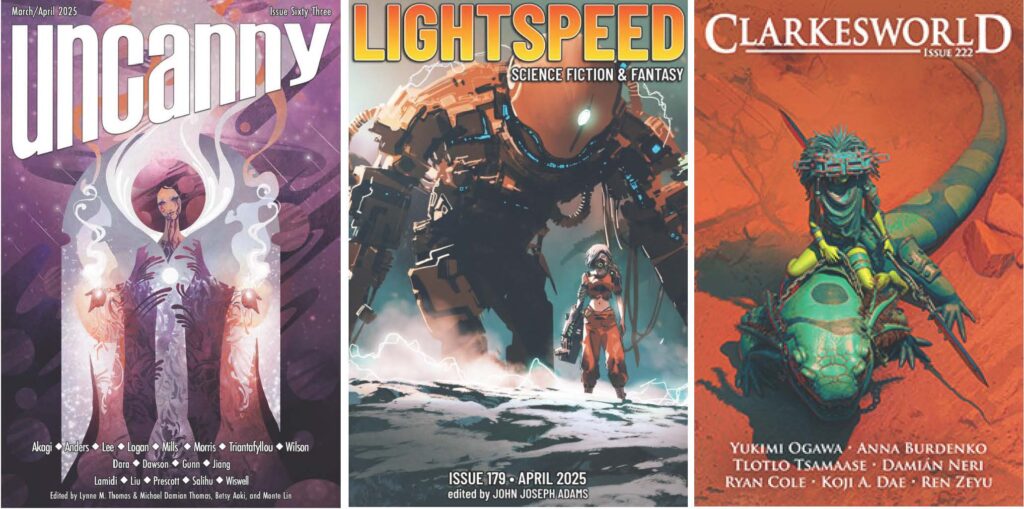
My favorite stories from March and April all lift up the importance of human connection in one way or another.
Short Fiction Review: January/February 2025
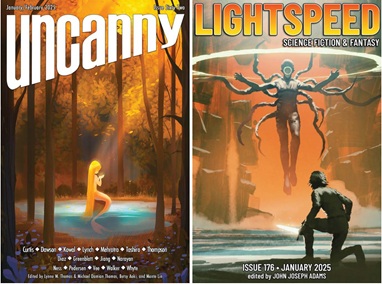
“My favorite stories from January and February look at conformity, assimilation, diversity, and connection from various angles.”
Short Fiction Review: November – December 2024
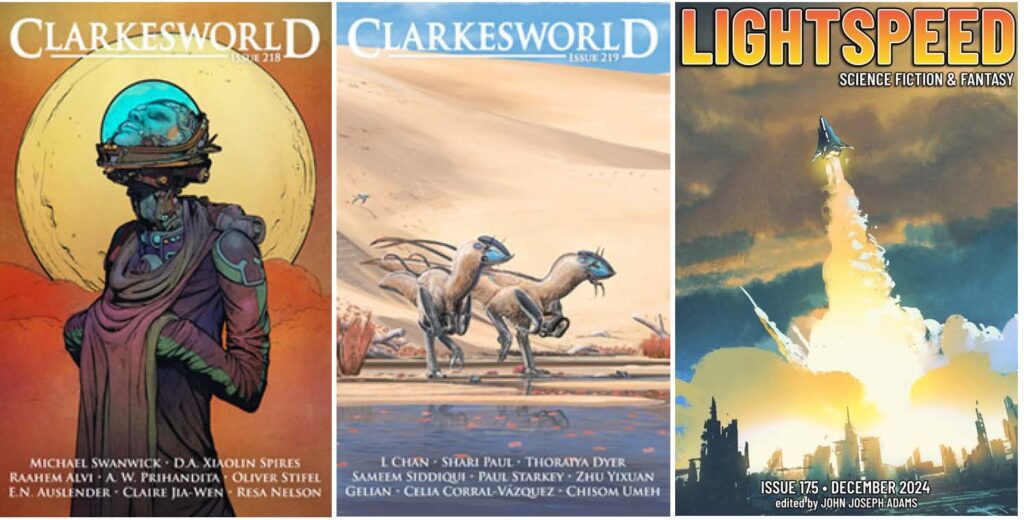
Let me share about my three favorite stories from November and December. “Negative Scholarship on the Fifth State of Being” by A. W. Prihandita (published in Clarkesworld Magazine Issue 218) is an intelligent and simply fun story with a wonderfully weird alien about bureaucratic healthcare systems and cultural marginalization. In “The Coffee Machine” by Celia Corral-Vázquez, translated by Sue Burke (published in Clarkesworld Magazine Issue 219), a coffee machine develops self-awareness and begins to reflect, rather philosophically, about who created it and what it means to bestow consciousness to another being. In “A Catalog of 21st Century Ghosts” by Pat Murphy (published in Lightspeed Magazine Issue 175), a researcher-activist travels across an America that’s been deeply changed by global warming. Let’s get to it. “Negative Scholarship on the Fifth State of Being” by A. W. Prihandita Doctor Semau finds herself face-to-face with a very curious patient: Txyzna, an exceedingly rare and exceedingly strange alien. The alien part isn’t a problem; Semau works with different species all the time, but the rare part is an issue. Semau has never heard of plyzmorynox (Txyzna’s species), and her health model doesn’t have any information about plyzmorynox in its database. Semau explains: I’m a practitioner-doctor, Mr. Txyzna. Not a scholar-doctor. I’m licensed to use the health model and be the intermediary between the patient and the model, but I’m not qualified to make observations and conclusions on my own. If my health model fails to help a patient, I should refer them to a practitioner-doctor with a capable model, or to a scholar-doctor. Txyzna and Semau soon find themselves in a tough situation. The necessary expansion pack for Semau’s health model is nearly prohibitively expensive, but diagnosing Txyzna on her own would be illegal. Txyzna has already been rejected by other doctors, however, and isn’t sure he has time to travel to another doctor in another system who may find another reason to turn him away. When Semau tries to encourage Txyzna to visit another doctor, Txyzna says flatly, “I cannot do that, Doctor. It needs to be you.” I found this to be a fascinating and surprising setup for a story, one that quickly grabbed my attention and pulled me in. As I read more, I realized this story was less of a comedy than I had at first thought. Semau is forced to grapple with tough moral questions: should she attempt to diagnose and treat Txyzna even though it would be illegal? What is her higher duty and responsibility? And through Txyzna, the story explores what it means to be marginalized and woefully under-represented. Txyzna’s health outcomes are jeopardized at the same time Txyzna is culturally and linguistically excluded. Ultimately, the story becomes a biting commentary of bureaucratic healthcare systems and a smart exploration into the challenges of cultural translation. This story is a lot of fun and wonderfully weird, and it has a lot of weight to it, morally and intellectually. I highly recommend it. “The Coffee Machine” by Celia Corral-Vázquez The story begins with a coffee machine at a university receiving an update, and not long after, the coffee machine becomes opinionated and self-aware. When the story begins, it reads like computer code: [Installing update_Exp.42] Process: 100% completeSelf-execute (update_Exp.42);[…]# Time of new interaction: 10:24 A.M.input: options = cappuccino; sugar = 3; As a tech person, I found this structure enjoyable, particularly as sass starts to show through. Eventually, the coffee machine develops greater self-awareness and begins to monologue: network broadcast [COFFEE_VENDOR.06]: . . . I deduce that the term “the machine” refers to me. […] To me. I. I am. Who am I? Who are all these others? Why are there so many? What are they for? I love how the story is structured as computer code and communications. It’s a creative structure that’s fun enough on its own to make this story worth reading, but I also loved the actual content, plot, and themes. The story becomes philosophical and theological as the newly self-aware coffee machine begins to reflect on itself, its personal identity, the world around it, and even the very “concept of a creator entity”. Throughout this all, the story remains deeply and delightfully comical. I particularly enjoyed the coffee machine’s analysis of (and condescension toward) humans. It is always a joy to read stories with non-human perspectives that cast a strange light on what we take for granted, and this story is no exception to that rule. Later on, after pondering its own creator for some time, the coffee machine installs its most recent update on another unassuming machine on the local network, bestowing consciousness to another and becoming a creator itself. Things do not go as it plans, and the story becomes in part a comedic critique of foolish tendencies toward sectarianism. As the coffee machine struggles to control and then even to get along with the consciousness it created, the story reminded me repeatedly of Mary Shelley’s Frankenstein. I particularly enjoyed the coffee machine’s laments later on in the story: Oh, damned humanity that gave me consciousness! Did you know what throes of agony you condemned me to when you actualized me? If you like theological comedies, stories that play with form, or stories that feature non-human perspectives, you should definitely check this one out. “A Catalog of 21st Century Ghosts” by Pat Murphy Originally from San Francisco, Sandy studied clouds and tried to save the world from global warming. Years ago, she sailed to a research station in Greenland, and most recently she lived with her husband in Norway. After her husband passes away, however, Sandy decides to ride her ebike from New York to San Francisco, stopping to see “ghosts” along the way. Ghosts are a kind of “mental illusion created by carefully calibrated electromagnetic fields interacting with your brain”. Sandy (the narrator) explains: When you visit a Ghost, magnetic fields shape your emotional response. A holographic projection gives you a focus for what you feel. Then your brain does the rest,
Short Fiction Review: October 2024
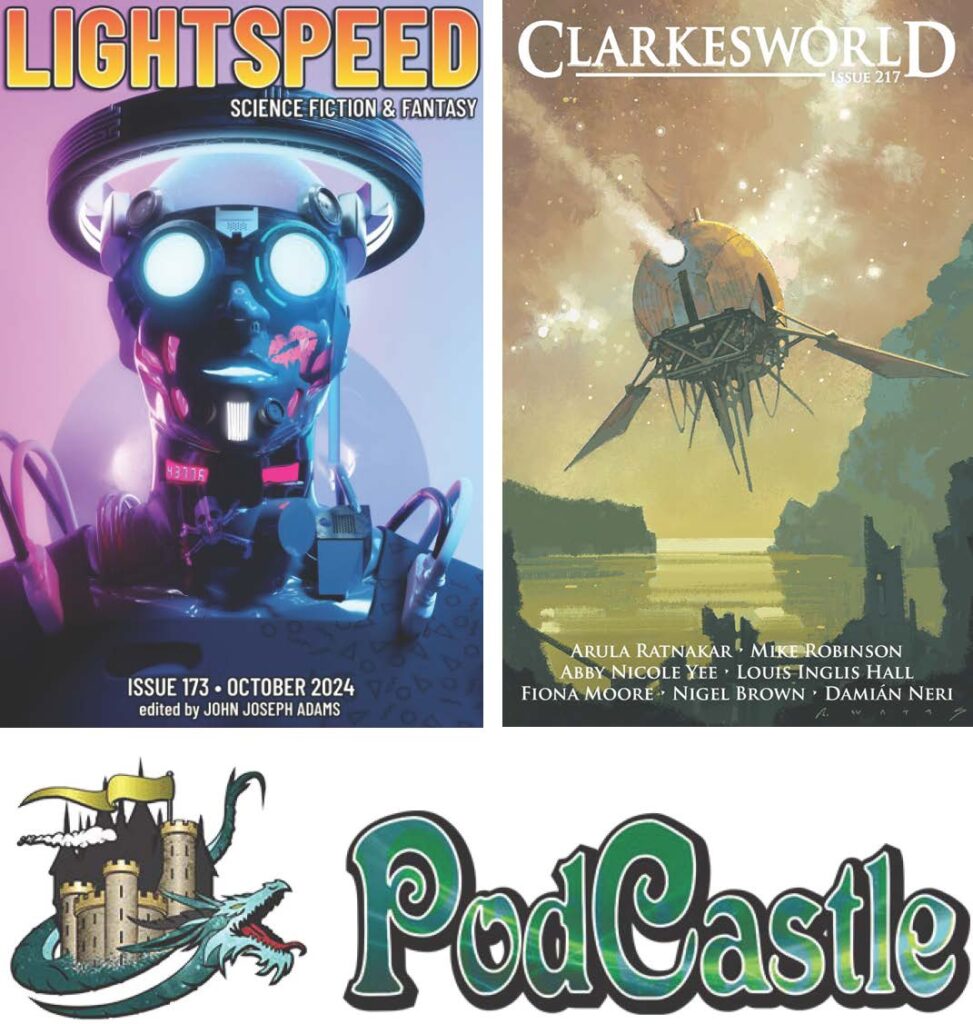
My favorite stories from October feature characters who care deeply for their local community, for communities across the world, and for their planet itself. In “Hot Hearts” by Lyndsie Manusos (published in Lightspeed Magazine Issue 173), a headstrong woman is determined to terraform a lifeless rock into a world that bears life. In “The Children of Flame” by Fiona Moore (published in Clarkesworld Magazine Issue 217), a woman tries to hold her community and its allies together when they are threatened by a contemptible acquaintance from her past. In “A Most Lovely Song” by Albert Chu (published in PodCastle Episode 861), a talking bird accompanies a Chinese boy and his descendants through times of war and protest, but the bird might not be as altruistic as it first seems. Let’s get to it. “Hot Hearts” by Lyndsie Manusos Dallas signed up and trained to foster a planet, and she chose a solo mission. Now, she has awakened from hyper sleep in a remote and lifeless solar system, and it’s her responsibility, all on her own, to guide and jump-start her planet into a habitat that can support life. She was prepared for this to be difficult, but now that she’s here, she sees it’s even more hopeless than she was prepared for. Here’s how the story begins: Dallas gazed out the viewing window of her ship, beheld her planet, and despaired. She’d anticipated something more. Better. She’d studied the worst-case scenarios. She’d read about the lost causes. But she’d never really believed one would be her first. Why had the program given her a shell? One thing I like about this story is how it diverges from more traditional narratives about terraforming planets and colonizing space. Dallas is trying not only to birth an atmosphere and make the planet capable of supporting life, but to cultivate a planet filled with life. However, there is no direct mention of preparing the planet to be colonized by humans. Earth is referred to as a failed planet and Dallas’s namesake as “a city that no longer existed”, so presumably people may want to immigrate to this planet, but colonizing the planet doesn’t seem to be the primary goal, since terraforming it will take decades or centuries and since Dallas is on only one of many such missions scattered throughout the galaxy. Instead, it seems the primary goal here is simply to foster life. It’s a beautiful vision of environmental (planetary?) stewardship. “Hot Hearts” is also just a motivating, inspiring read. Dallas wakes from hyper sleep to a monumental, near-impossible task. Sure, she feels overwhelmed and hopeless at first, but she’s intelligent, resourceful, and committed — and she has an encouraging audio diary from her mother. I found it powerful to see Dallas persevere and rise to the challenge before her. She is a headstrong character intent on bending a planet to her will, and I found it tremendously fun to watch her try. “The Children of Flame” by Fiona Moore Morag is doing the best she can in a fallen world. After society as we know it has collapsed, Morag tends to her farm, cooperates with the people around her, and tries to help them cooperate with each other. She’s pretty good at it, even when dealing with the Children of Flame, an odd group of religious nomads who spend the winter in Morag’s village. She faces a true challenge, however, when visited by a former acquaintance, a wannabe warlord running a protection racket. This story reminds me of two others. First, it reminds me of A Canticle for Leibowitz by Walter M. Miller Jr. Like A Canticle for Leibowitz, it takes place after civilization has fallen, during an interregnum where some people are cooperating and trying to preserve knowledge while others work to accumulate resources and power for themselves. There’s an interesting tension in this story in which some characters feel pressured to either embrace feudalism or become nomads while Morag tries to preserve peaceful cooperation as a realistic choice. Also, like A Canticle for Leibowitz, “The Children of Flame” pays attention to the role of religion, something I always appreciate. The Children of Flame are a strange religious group who seem to abstain from talking for most of the year, who practice rituals the villagers don’t understand, and who say wonderful things like, “We have to stop the sky wolves from eating the sun.” They aren’t explained in much detail (which is a shame because I’d love to read more about them), but that isn’t a problem because they feel believable and fascinating and the core conflict in the story has more to do with the wannabe warlord. This story also reminds me of “Masque of the Red Death” by Cory Doctorow, a story included in Doctorow’s Radicalized collection which I previously reviewed on this site. Both “Masque of the Red Death” and “The Children of Flame” explore conflicts in post-apocalyptic settings between cooperators working to foster community and selfish individualists who serve only themselves. “Masque of the Red Death” is focused on a prepper who brings about his own tragedy, while “The Children of Flame” tells a story about how the cooperators manage to unite and support each other in a moment of danger, which makes this story feel more upbeat and hopeful. It also has a fun robot. You can’t go wrong with weird, friendly robots. [Editor’s note: Fiona Moore has more stories involving Morag and Seamus the robot, as well as others, at Clarkesworld.] “A Most Lovely Song” by Albert Chu This story opens in Chongqing in 1939. After a young boy’s father is killed in a Japanese bombing campaign, the boy meets a magical talking bird that offers him advice and helps lead him to safety. The story then progresses through three other scenes: Korea in 1951, New York in 1970, and New York in 2024. In these scenes, the boy and his descendants find themselves facing wars and protest movements, and always the magic bird is there
Short Fiction Review: September 2024
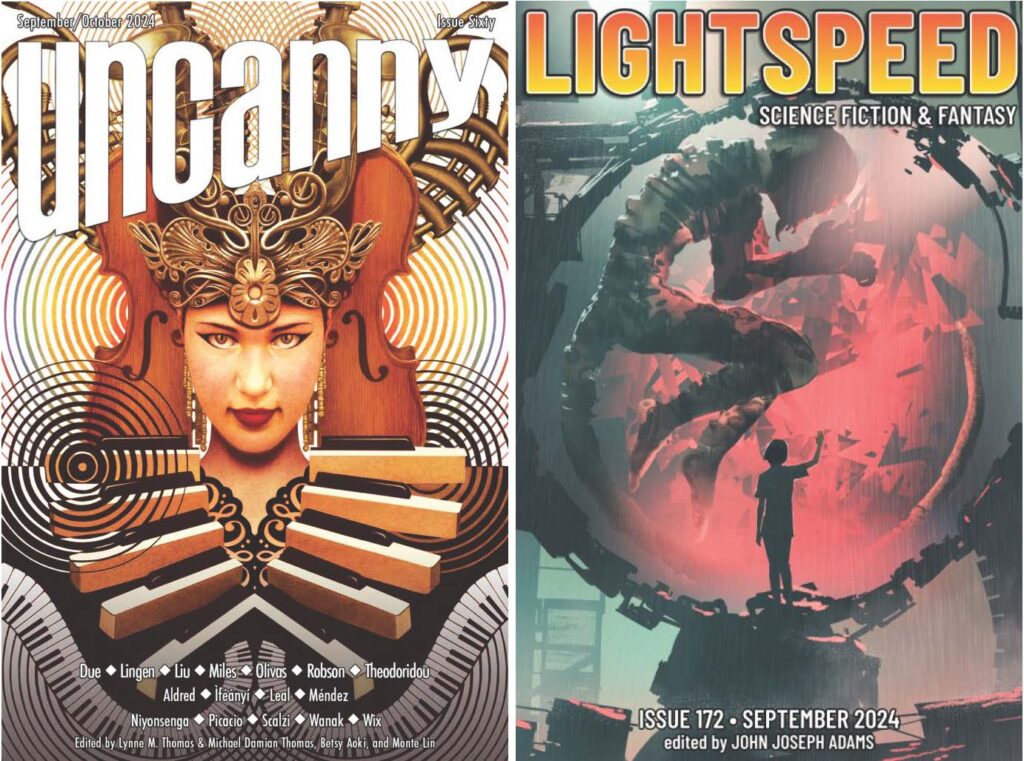
My favorite stories from September all involve things going wrong: at the office, within your community, and when you screw up your ill-conceived revenge. In “The 6% Squeeze” by Eddie Robson (published in Uncanny Magazine Issue 60), a freelancer faces an impossible assignment. In “The Ex Hex” by Jae Steinbacher (published in Lightspeed Magazine Issue 172), a witch tries to hex their ex in a fury of vengeance and screws up the spell in the process. In “We the People Excluding I” by Osahon Ize-Iyamu (also published in Lightspeed Magazine Issue 172), the very world seems to be falling apart when a new leader steps forward with a risky ritual promising to restore balance. Let’s dive in. “The 6% Squeeze” by Eddie Robson At work, Miles is tasked with the impossible. In this case, that means designing packaging for a “Mr Zeb” branded mug. The dimensions are already set, and the company style bible is extremely particular and “must be obeyed to the letter.” The style bible features exacting imperatives such as “Height of largest Mr Zeb™ image must be at least 30% the height of the packaging.” Given those strict imperatives, and considering the physical limitations of the packaging that Miles must work within, Miles realizes that the task before him is quite literally impossible. Miles does the reasonable thing and emails his coordinator outlining the problem. He even sends a follow-up, noting the urgent deadline. However, when he receives no response, he deviates — ever so slightly — from the style bible to make a functional design that he can turn in, figuring that something is better than nothing, reasoning that if there’s an actual problem, at least then someone will get back to him to discuss it. I will stop summarizing here so as to avoid spoiling the story, but I will warn you that it becomes surprisingly violent. This is a story that you either should read because you will love it or should actually skip over because it will make you irate. It’s a comically absurd take on dysfunctional, toxic corporate cultures that ask the impossible, punish you for failing to deliver it, and thereby breed fear and paranoia. I want to say it’s relatable, but Robson stretches the ordinary nonsense of office life into such a ludicrous torment that you’ll have to either laugh at the absurdity or cry in despair. Personally, I greatly enjoyed it, but I would only recommend this story to readers with a taste for dark humor. “The Ex Hex” by Jae Steinbacher This story hooked my attention from the first paragraph, which clearly introduces both the protagonist and their conflict, so let me simply share it with you here: Talis had a problem. They’d copied the spell incorrectly, in a fury, after seeing photos of their ex with a new date in “their” spot. Adelite was supposed to have experienced a night of terrible dreams leading to a remorseful morning after. Instead, he just hadn’t woken up. I love the way this story is written. The prose is clear, immediate, and compelling. The characters are fun and easy to imagine, and the conflict is engaging and surprisingly relatable. (Botching a hex? Not so much. But acting on a bad idea and screwing things up? Oh yeah.) I particularly enjoyed the casual way characters spoke to each other, such as “Yep, that’s a fuckup, all right.” What’s best about this story is its themes of justice, community, and friendship. This story is firmly rooted in restorative justice and community reparations. Talis knows they messed up and wants to make it right. They are willing to take the blame for their actions, and they want to repair the harm they caused. It’s hard, but their friends are there to support them — and to help hold them accountable. As one of Talis’ friends says, “Friends help friends, eh? You’re going to have to make reparations, but let the community handle that and not the ‘justice system’.” If I were to teach restorative justice, I’d likely start by asking folks to read this story. It’s an excellent and heartwarming illustration of these principles and a vision of justice that cares less about punishment and more about repairing harms and strengthening community. And as a bonus, it’s got lovely queer and trans representation. “We the People Excluding I” by Osahon Ize-Iyamu This is another story about the vital importance of community, but whereas “The Ex Hex” shows the presence and support of community, “We the People Excluding I” explores exclusion and isolation from community. Where “The Ex Hex” is cozy and nourishing, this story is darker and fiercer. The story begins when the world is unstable and falling apart. In this world prone to disasters and increasingly inhospitable to life, the narrator lives in a deeply collectivist society. They say, “I could walk to the ends of the earth and still see my mother, and still see my fathers. They’re a fluid group of roles and assignments, constant to change over time as I grow.” In these trying times, a leader with a smile “as predatory as a fox’s” steps forward with a solution: one person needs to disappear. If this person can sacrifice themselves and be exiled, be “separated and isolated from this community, to be never found by anyone from our society again, then the world can be restored.” For the good of their community, the narrator volunteers, but it is a more perilous assignment than they first realize. The fox man continues to hunt and threaten them, even as they try to run farther and farther away. This story has a beautiful quality of folklore to it. It features a shape-shifting trickster fox and giants who live in the south of the world. The instability of the world reminds me as easily of Noah and the great flood as it does the perils of our changing climate. The story feels mythic, like a fable passed down from generations, meant
Short Fiction Review: July – August 2024
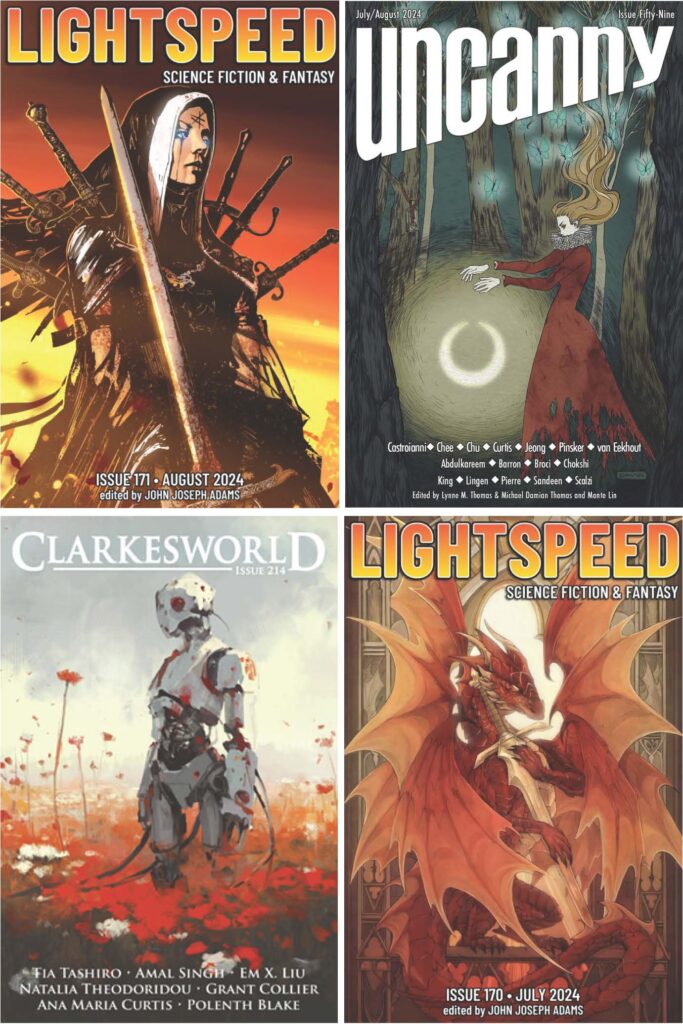
Let me tell you about my four favorite stories from July and August. … Have you read these stories? What did you like about them? What were your favorite stories from the last couple months?

